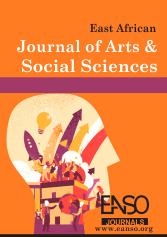The Devastating Effects of Gender-based Violence on Household Well-being: A Case Study from Kinondoni Municipal, Tanzania
Abstract
The study assessed the effects of gender-based violence towards household well-being in Kinondoni Municipal in Tanzania. The study employed a survey design whereas a qualitative approach was employed though the study was conducted based on subjective reality testing. Primary data were employed in the process of knowledge generation. Facts were collected from the subjects of the situation and the key informants from the respective entities engaged in gender-based violence (GBV) from the sample of 120 participants. The study was conducted in Kinondoni Municipal and data were gathered using questionnaires and in-depth interviews. The collected results from the field using questionnaires were computed in SPSS software whereas descriptive statistics were generated to present the results. Results gathered through interviews were analyzed using content analysis techniques which were narratively presented with themes to complement the results. Findings indicated that gender-based violence indeed constitutes negative effects alone on the households' well-being since in the end it fosters destructions, enmity and hatred among the actors that may culminate into other negative results once the situation is not worked to be resolved. The implication of the results is that gender-based violence is indeed a destructive practice that is not the behaviour that is encouraged to escalate for the well-being of the families. Therefore, it is recommended that measures towards addressing the cultural aspects by the government and non-state actors should be encouraged to ensure that emancipation positively occurs
Downloads
References
Amoakohene, M. I., Smith, M., & Tietaah, G. K. M. (2015). Intimate partner violence impacts university students in Ghana. Athens Journal of Social Science - Volume 6, Issue 1 – Pages 19-34
Creswell, J. W. (2013). Qualitative inquiry & research design: Choosing among five approaches. Sage Publications.
Creswell, J. W., & Creswell, J. D. (2018). Research design: Qualitative, quantitative, and mixed methods approaches (5th ed.). Sage publications.
Creswell, J. W., & Plano Clark, V. L. (2011). Designing and conducting mixed methods research. Thousand Oaks, CA: Sage.
Creswell, J. W., & Plano Clark, V. L. (2018). Designing and conducting mixed methods research (3rd ed.). SAGE Publications.
Ezekwesili, O. (2017). Invisible no more: African women speak out on violence and gender disparity. Penguin Random House.
Gelman, A., Carlin, J. B., Stern, H. S., Dunson, D. B., Vehtari, A., & Rubin, D. B. (2013). Bayesian data analysis (3rd ed.). Chapman & Hall/CRC
Goode, W. J., & Hatt, P. K. (1980). Methods in Social Research. McGraw-Hill.
Hinduja, S., & Singh, A. (2018). Cyberbullying and gender-based violence. Journal of Interpersonal Violence, 33(15): 2009-2037
Johnson, M. P. (2020). Understanding men who use intimate partner violence. Psychology of Violence, 10(2), 223-234.
Kinondoni Municipal Council. (2018). Kinondoni District Profile. Retrieved 10.08.2024 from https://kinondonimc.go.tz/storage/app/media/uploaded-files
Kombo, D. K., & Tromp, D. L. (2006). Proposal and Thesis Writing: An Introduction. Nairobi: Paulines Publications Africa, 5, 814-830.
Kothari, C. R. (2019). Research methodology: methods & techniques (Revised 4th ed.). New Age International (P) Ltd: New Delhi.
Kothari, C.R. (2019) Research Methodology: Methods and Techniques. 4th Edition, New Age International Publishers, New Delhi.
Malcolm, T. (2019). Documentary Research in the Social Sciences. SAGE Publications Ltd.
Malgesini, G., Sforza, L. C., & Babović, M. (2019). Gender-based violence and poverty in Europe. EAPN Gender and Poverty WG - Briefing # 2.
Mary. N. (2019) Gender-Based Violence and Psychological Well-Being of Women in Kigulu North, Iganga District. Kampala International University. College of Humanities and Social Science
Muzavazi.W, Makochekanwa. A, Moyo.S, Mhloyi.M & Mundau.M (2022) A Comparative Analysis of the Causes of Gender-Based Violence against Women between Low and High-Income Households in Manicaland Province of Zimbabwe, Cogent Social Sciences 8 (2), 14-15
National Bureau of Statistics (NBS) (2022). National Census of People and Housing of 2022, Ministry of Finance and Planning, Tanzania
Ojo, E. A., Daniel, E. O., Adeniyi, D. S., Ojo, A., Ikani, P., Abiodun, P. O. Olagbegi, O. M. (2023). Prevalence and causes of gender-based violence (GBV) among students in tertiary institutions in Abuja, Nigeria. World Journal of Public Health, 8(2), 192-193
Shimba, C., & Magombola, D. (2019). Social and health effects of gender-based violence on women in Arumeru District, Tanzania. Tengeru Institute of Community Development. European Journal of Research in Social Sciences.9 (1), 57-60
Silverman, David. 2013. “What Counts as Qualitative Research? Some Cautionary Comments.” QualitativeSociology Review 9(2):48-55. Retrieved (http://www.qualitativesociologyreview.org/ENG/archive_eng.php)
Timbuka, L. (2018). Violence Against Women and Children in Tanzania still rampant. TAMWAnites Konnect, (007), 2-3.
UN Women. (2023). Progress on the Sustainable Development Goals: The gender snapshot 2023. United Nations.
UNFPA. (2023). Gender-based violence. United Nations Population Fund. Retrieved 22.08.2024 from https://www.unfpa.org/gender-based-violence
UNHCR. (2022). Syria: Protection monitoring report (January-December 2022). United Nations High Commissioner for Refugees.
URT, UNICEF and Partners. (2016). National Plan of Action to End Violence against Women and Children in Tanzania (NPAVAWC), 2017/18–2021/2022. Five-year National Plan of Action. Government of the United Republic of Tanzania, UNICEF and partners
URT. (1996). Community development policy. Ministry of Community Development, Elders and Special Groups.
USAID. (2021). Gender-based violence. United States Agency for International Development
UNDP. (2020). Gender-based violence and women's health in Tanzania. United Nations Development Programme.
Wanjiru. Q., (2021) Causes and effects of Gender-Based Violence. A critical literature review. Journal of Gender-Related Studies, 2(1), 43–53.
WHO, (2022).Violence against women. Retrieved from https://www.who.int/health-topics/violence-against-women#tab=tab_1
World Bank (2022). Tanzania can do more to protect women and girls by urgently addressing gaps in efforts to combat gender-based violence. World Bank Group Retrieved 16.07.2024 from https://www.worldbank.org/
World Health Organization. (2022). Global and regional estimates of violence against women: Prevalence and health effects of intimate partner violence and sexual violence. World Health Organization. New York: UN.
Yurianto, A. F., Susanti, D. A., & Nursalim, M. (2024). The importance of psychoeducation as an effort to prevent sexual violence in adolescents. In Proceedings of the 2nd International Conference on Guidance and Counseling: Counseling Resonances on Mental Health Emergencies and Awareness. State University of Surabaya. https://icgc.unesa.ac.id/
Copyright (c) 2025 Ninza Mbaza

This work is licensed under a Creative Commons Attribution 4.0 International License.




























